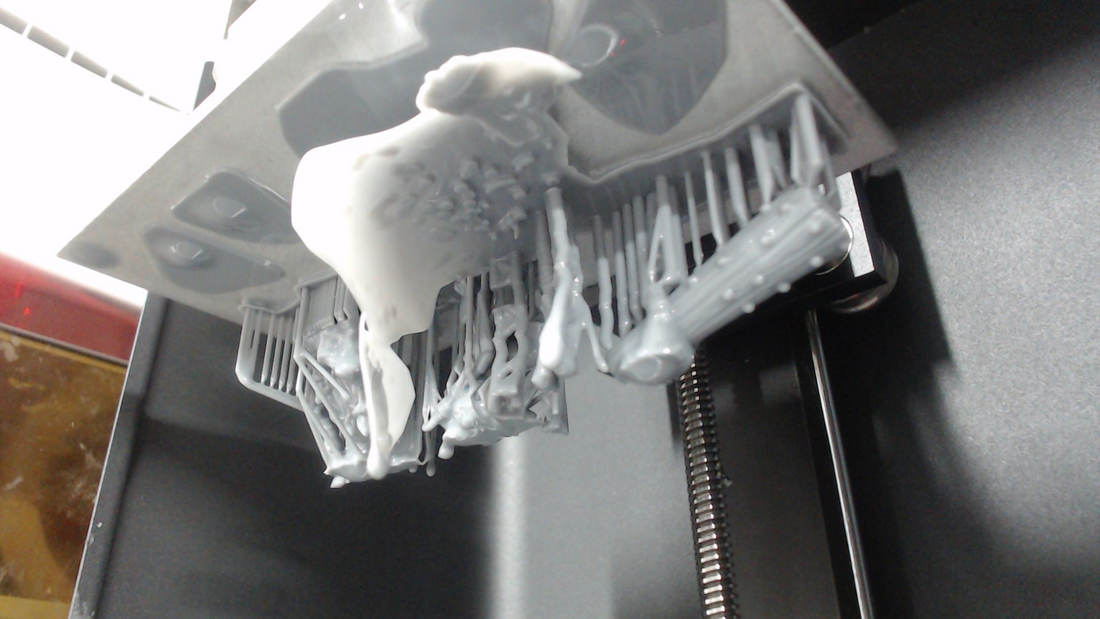
Lessons Learnt: 3D printing fails due to cold weather and low resin temperature
Dan KellyShare
I've been 3D printing in resin since 2016, and my very first resin printer was an Asiga Pico2 HD which I used for commercial 3d printed master miniatures to go into resin moulds. In fact, fun fact for you, the reason I have used Yellow in my branding and renders over the years is because all of my 3D prints always used to look like this! The models shown are from left to right - Male Monk, Warhound and Male Rogue (just in case you're interested!)

The reason I mention this here, is that the Pico2HD unlike any other consumer printers out at the moment has internal print chamber heating that raises the print chamber temperature to 30C before any printing begins, and maintains that throughout. Its a fantastic feature and the sealed print chamber means that you don't need to worry about ambient temperatures when printing so its one less thing to fail!
TLDR
This is the story of how I did a series of prints after warming my office from 5C to 23C. The resin was still cold though and resulted in failures. Only on my 3d consecutive attempt was the resin warm enough to print properly. Be sure that you warm your resin on cold days or your prints will fail badly! The fails shown in the images here were due to the resin being too cold even though the printing environment had been heated to 23C.
What Happened?
The last few live streams I've done for the Cursed Empire miniatures range, I've been working on a model called a Trogre - not surprisingly its a cross between a Troll and an Ogre, but he is massive - a good 80mm tall even with his stooped pose. I supply the models to Chris at Cursed Empire as part of our arrangement with supports fully provided and tested, so following completion of the sculpt on Tuesday (10th Jan), I promptly got on with doing the supports.
Once the supports were complete I had customer prints on the printers so I had to wait for them to finish to get the Trogre on test. They finished quite late in the evening, so I shut down the printers, turned off the heating etc in the office and locked up for the night.
First Fail
The next morning I come in and the office temperature was just 5C! I put the heaters on to get the temperature up and a couple of hours later we were at 23C. Before I started my live stream for the day at 10am I put the Trogre test print on my Epax X1 4k. Later that day at around 4:30pm the printer beeped and I went to go and check on it, only to be greeted with this horror scene!

You can see that the first few base layers are fully stuck to the plate, but then the subsequent layers have delaminated and peeled away from the base and failed to print. Somehow though, the parts at the back didn't completely fail but they were far from perfectly formed.
Second Attempt
I put the print on my other printer (sonic Mini 4K) while I sorted out this mess, having to empty the vat and remove cured material from the FEP. This print was due to complete late in the evening when I wouldn't be in the office, but I wanted to check on it so I went back and checked again late to see how it was looking and once again.
I went back into the office about 11pm and was greeted with this new variety of atrocity!

You can see that it fared much better than the original print, but the raft has detached from the plate early in the build leading to movement throughout the print and wobbly supports. The model itself seems to be not too bad but the chances of the print succeeding with this level of instability is slim to none.
Third Time Lucky!
At this point, the office is still warm and I decided to try the print one last time, so after cleaning the vat, filtering the resin and removing cured resin from the FEP, I set the print going again, and set a timer to turn off the heater once the print was at the end.
In the morning, I eagerly headed to the office to see what abomination lay in wait, and to my astonishment, I was greeted with a perfect print!

Now I hadn't changed anything at all in regards to settings or supports, the only variable was the temperature. It had occurred to me that at the time I started the first print, the resin would have only been around 5-6C which is far too cold to print effectively (as demonstrated rather well in that first picture!). The resin had then been exposed to ambient air temperature around 23C for the 6 hour duration of the print before the next print went on. During those 6 hours, the air temperature needed to penetrate through the plastic bottle and all the way through the resin bottle to help bring the temperature up. Resin operates best at temperatures in excess of 21C, but that is the RESIN temperature NOT the ROOM temperature! So despite my room being a toasty 23C, the resin had probably only warmed up to be about 15-16C at the point the second print went on. By the time the final print went up, the resin and bottle had been sat in the toasty warm office all day and so must have reached a good temperature for printing.
Lessons Learnt!
1 - Ambient Temperature vs Resin Temperature
Whilst the ambient temperature needs to be over 21C for ideal printing conditions, this assumes that the resin is stored in this same environment and is also at a similar temperature. It is therefore critically important that when rapidly heating a room to print, you must also get your resin up to a good temperature.
Placing the (tightly closed) resin bottle in a bowl of hot water and rotating it occasionally will effectively bring the temperature of the resin up to a usable level if the weather is cold. be careful not to contaminate your resin with water, so always dry the bottle thoroughly before opening and decanting it.
2 - Calibration/Exposure Time is environmentally dependent!
Essentially, as a resin warms up it becomes less viscous (i.e. thinner), and requires a lower exposure time. Colder, thicker resin will require a longer exposure time to cure it (and depending on how cold it may not even cure properly at all).
If my printer was calibrated in a 21C room temperature environment and requires a 1.4 second exposure, as the ambient temperature drops this exposure requirement will increase meaning I should repeat the calibration under the new environmental conditions to be able to achieve optimal results - a good print should still be achievable but will take significantly longer
You may see the effects of this if you print overnight without ensuring consistent heating in the print area - the model may fail inexplicably part way through the print, and this can just be due to the temperature at night dropping.
Cursed Empire
If you like the Trogre model and the Darkuns that surround it, they're all part of the world of Thargos which you can explore in the various Cursed Empire games, from the Heroes of Thargos card game, through to the Role Play game which is bracing for a 3rd Edition release, and the upcoming TTRPG Dungeon Crawler that will extensively make use of our miniatures!
it's also worth noting that the RPG system is a unique ruleset and is unaffected by any of the WOTC OGL issues, so if you're looking for an alternative system be sure to give Cursed Empire a go! More about the game and systems at https://www.cursedempire.com/
